2007 VOLKSWAGEN GOLF PLUS warning lights
[x] Cancel search: warning lightsPage 124 of 541
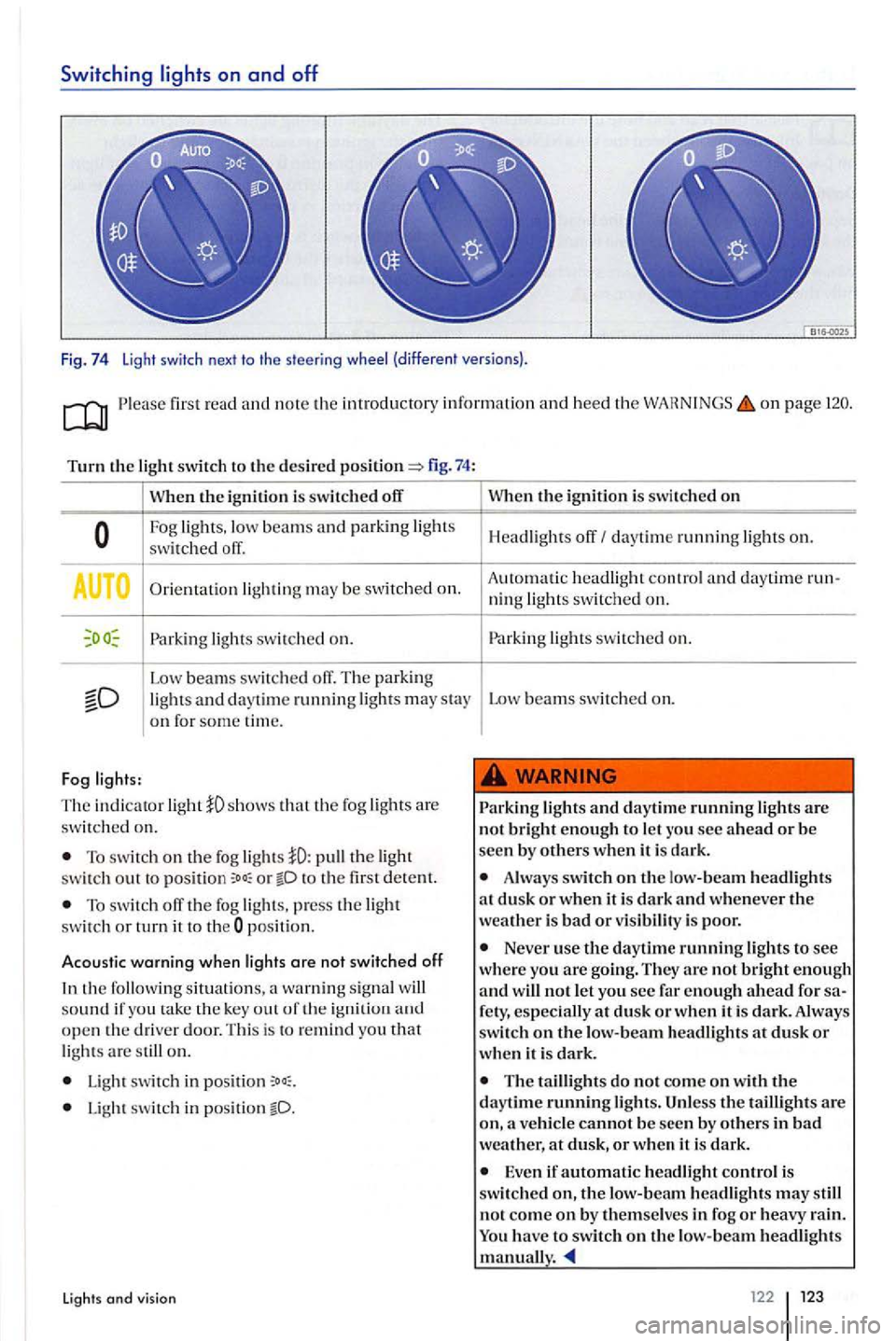
Switching lights on and off
Fig. 74 Light switch next to the steeri ng (different versions).
first read and note the introducto ty information and heed the o n page
Turn the switch to the desired fig . 74:
When t11e ignition is swit ch ed off
Fog lights,
Orientation light ing may be switched on.
light s sw itched on.
--Low beam s swi tc h ed off. T he park ing and day tim e runnin g light s may stay on for some time.
Fog
The indicator light
To switch on the fog the swi tc h out to o r to the first detent.
T o switch th e fog lights, press the ligh t switch or turn it to t he pos ition.
Acoustic warning when lights are not switched off
the following situati on s, a wa rnin g sig nal sound if you take the k ey out o f th e op en th e driver door. This is to remind you that lights are on.
Light switch in
Light switch in position
Lights and vision
t11c ignition is swi tched on
Headligh ts daytim e running on.
A ut
omatic headligh t and daytime ning lights sw itched on.
switched on.
Low beams switched on.
lights and daytime running lights are not bright enough to let
Always switch on t11e lo w-beam headlights at dus k or when it is dark and whenever weather is bad or visibility is poor.
Never use the daytime running lights to see where you are going. They are not bright enough and will not let you see far enough ahead for
The taillight s do not come on t11e daytime running light s. the taillight s are on,
Even if automatic headlig h t control is switched on, the headlights may st ill
not come on by themsel ves in fog or heavy rain. have to switch on the low-beam headlights manual!.
122 123
Page 132 of 541
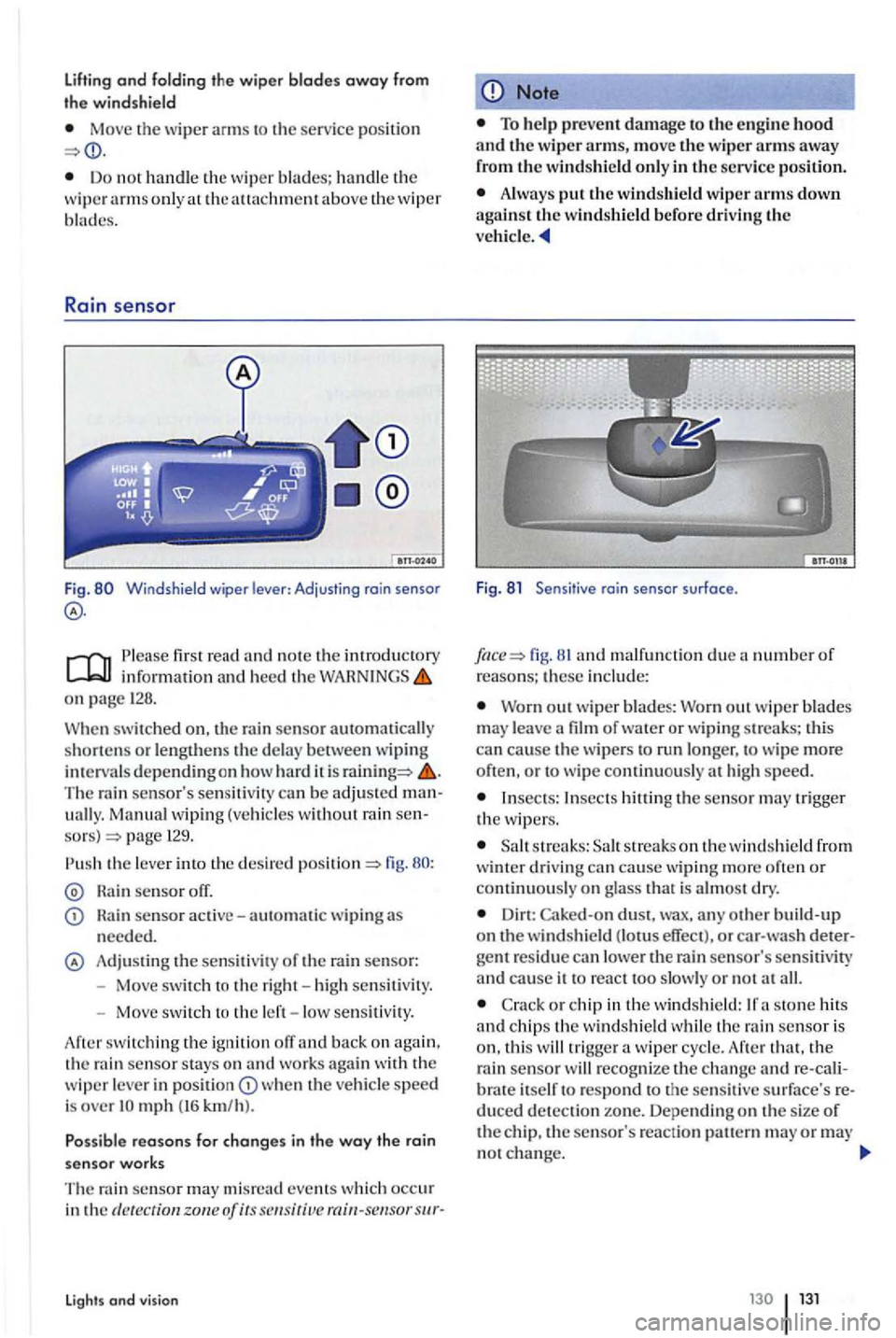
lifting and folding the wiper blades away from
th e
windshield
Move the wiper arm s th e serv ice position
Do not handle the wiper b lades; h andle the
wipe r arms o nl y at the a uachment above the w iper blades.
Rai n sens or
Fig. Windshield wiper lever : Adjusting rain senso r
first read and note the introductory information and heed th e WARNINGS on page 128.
When
swit ched on. the rain sensor automatically
shorte n s or le ngthens the de lay betwee n wiping in tervals depend in g on how hard it is The rain sensor's sensiti vity can be adjusted manuall y. Manual wiping (vehicle s w ith out rain sensors) page 129.
Rain sensor off.
sensor active-automatic wiping needed.
Adju stin g the sensit iv it y of the rain sensor:
- Move switc h t o the right -hi gh sen siti vity.
- Move sw itch to the left - low se nsitivity.
swit ch in g th e ignition off an d back on again ,
t h e ra in sensor stays o n and works agai n with the wiper leve r in w he n the vehicle speed is over
events which occur in the dete ction zone of its
Lights and vision
Note
Always the windshield wiper arms down against the windshield before driving the ve hicle.
Fig . 8 1 Sensit ive rai n sensor surface .
fig. 81 an d malfu nction due number of reasons; these in clu de:
Worn out w ip er blades: Wo rn out w iper blades m ay lea ve a film of water or w ipi ng streaks; thi s can cause the wipers run longe r, to wip e more often , o r to w ipe continu ously at h ig h speed.
Insects: Insects the sensor may tri gger the w ipers .
s tr eaks: streaks o n th e w indsh ie ld from
w inter drivin g can cause wiping more often or continu ously on g lass that is almos t dry.
Dirt: Caked-on dust, wax, any build- up on the windshield (lotus effect), or car -w ash detergent residue can lower the rain sensor's sen siti vity and cause it to react too slowly or n o t all.
C ra ck or chip in the wind shi eld :
th at, th e
rai n sensor will recog nize the c ha nge re -cal iitself to respond to the sensit ive su rface's reduced detection zone. Depending on th e s ize of the chip, the sensor's reaction ern may or may no t change.
Page 181 of 541
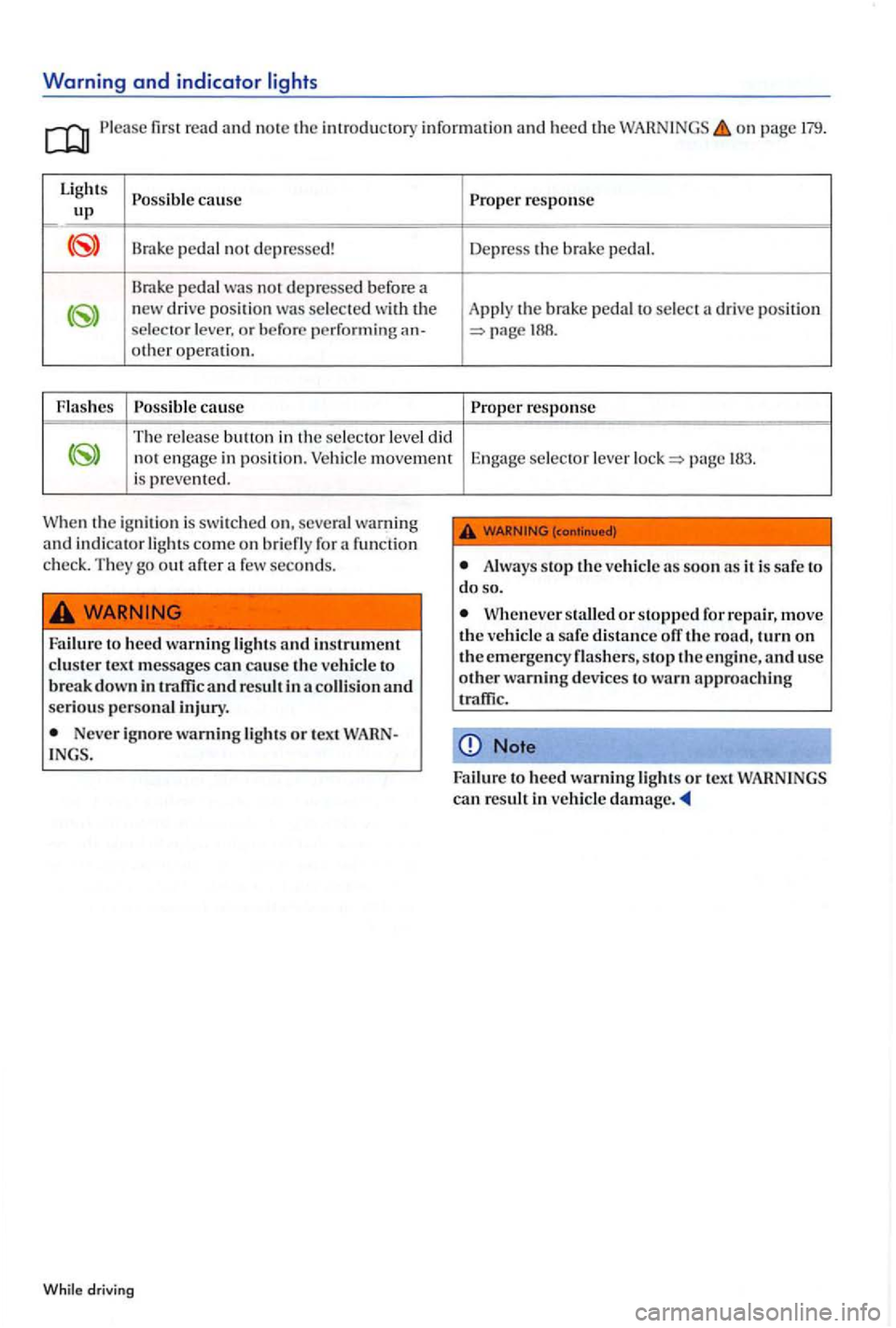
Warning and indicator
Please fir st r ead and not e th e int rod uc tory informatio n and heed th e on pag e 179.
Light s
Possibl e cause up
Brak e pedal not d ep ressed!
Brake pedal w as not depressed before a new drive position wa s selected with the
se lec to r l eve r. o r be fo re pe rformin g
Possibl e caus e
The re lease bul!on in th e s elec tor leve l did
n o t en gage in po siti on. V ehicle is preve nted.
th e ig niti on i s s witch ed on, seve ral warnin g
and indica to r lig hts c om e on briefly fo r a function
c heck . T hey go out aft er few sec o nd s.
to hee d warning light s and in strument
clu ste r te xt m essages cause the v ehicl e to
b reak d own in and result in colli sion and seri ou s persona l injury.
Neve r ignore warning lig ht .s or t ext
drivin g
Prop er re sponse
Dep ress the brake pedal.
Appl y th e brake pedal to sele ct a dri ve position
Prop er re sp o nse
E ngage se lecto r lev er
page 183.
Alwa ys stop the ve hicl e as s oo n it is safe to
d o s o.
stalled or stopped f or r epa ir , move the ve hicl e a safe di sta n ce
Note
Fa ilur e to heed warning lights o r tex t
Page 189 of 541

Braking, stopping, and parking
Introduction
In this section yo u'll find inform ation on fo l
lowi ng:
Warning and indicator lights . . . . . . . . . . . . . . . . . 189
Park in g brake . . . . . . . . . . . . . . . . . . . . . . . . . . . .
.. . . . . . . . . . . . . . . 19 1
About t
he brakes . . . . . . . . .. . . . . . . . . . . . .. . . . 192
Bra king assistance sys tem s . . . . . . . . . . . . . . . . . . . . 194
Switching Anti-Slip Regulation (ASR) on ond off . . 196
Brake fluid . . . . . . . . . . . . . . . . . . . . . . . . . . . . . . . . . 196
T he brakin g support syste ms are Brake A ss is t E lec tro nic Differ e n tial Loc k (EDL). Anti-Slip
M ore information:
Trail er page
pag e
Tires and page 276
acce ssories, r epa ir s and modifi catio ns
brakes or worn brake pads can
ca use colli sio n and serious personal inju ry.
light s up in the
in strument cluste r di splay, w heth er a lo n e or to
ge ther with tex t message, immediat ely conta ct an authorized Volk swage n dea ler or authorized
Volkswag en Se rvi ce Faci lity to have th e brake pad s ch ecke d and , if necessary, re pl aced.
WARNING
improperly can cause se riou s pe rso nal
injury .
Never re m ove key from the ignition switch while vehicl e is m ov ing or ro llin g to a
s top. The steering w heel w ill lock and you not be
Never park the vehicle w here the ho t ex ha ust
syste m or catalyti c convert er could ignit e flam
mabl e mater ia ls, su ch as brus h , leaves , dry grass, spilled fue l, e tc .
Always apply th e parki ng brake whe n
p a rki ng your veh icle. Imprope r u sc of th e
p a rking bra ke can se rio usly injur e you and your passe nge rs.
Never use the
e m ergency . The stopping dista n ce is muc h
longer b ec au se onl y the wheels arc braked . use the foot brake to sto p the vehicle .
Never the throttl e from
th e e ng in e
th e automati c transmission is in gear. The ve hicle will start t o move as soon the e ngine speed ev en i f th e brake is on.
Never leave childr en or anyo ne w ho canno t
h elp them se lve s beh in d in the vehicl e. They could re leas e the brak e move the gear selector leve r or shift , wh ic h could cause th e vehicle to start m ov ing. Thi s ca n lea d
to a cras h and seri ous personal injuri es.
Always take the key with you when yo u
leave th e ve hicle . The engine ca n be started and ve hicl e sys te m s s uch as the power wind ows can
b e operate d , le ad ing to seri ous perso nal injury.
Neve r leave childr en , di sabled perso ns, or a nyon e who cannot h elp them se lves in the vehicl e. T he doors can b e lo cke d wit h the re mote contro l ke y, trapping passe nge rs in the
ve hicle in an emerge ncy. For exa mpl e, dep ending on th e tim e of year, people trappe d in the
ve hicle can be ex pose d to very high or very temperatures. Heat build -up in the passenger and parked vehicl e result in temperatu res in the ve hicl e th at arc much hi gher than the outsid e tempe mtu
res, partic ul arl y in summer. T emperatures ca n
qui ckly reac h le v e ls that can cause uncon
scio usn ess ch ildr en.
Page 191 of 541

Lights cause or up
I
Together w ith indicator
m alfun ction.
T oge th
er with warning light
cause
or is opera ting.
W hen the ig nition
is sw itched on,
light s and instrument cluster text messages can cause the vehicl e to
break down in traffic and result in a collision and serious personal injury.
Never ignore warning light s or text WARN
Always stop the vehicl e as soon as it is safe to
do so.
Driving
with bad brake s can cause a collision and serious p ersonal injury .
does
not go out, or co mes on w hen driving, either the brak e fluid leve l in the reservoir is too low or there is a fault in the brake sys tem. Immediately
s top driving and get expert assista nce
response
Take the veh icle to an authori zed Volkswage n
d ealer or authori zed Volkswagen Service Fa-The ve hicl e brake s will work without
response
foot off accelerator pedal. Adapt driving to road conditi ons.
If the brake warnin g light BRAKE or co mes on at the same time as the warning light or th eABS may not be working properly. Thi s
could cause th e rear whee ls to lock up re latively
quickly during braking. Rear wheel brake lock
u p can cause loss of veh icle control. If yo u be
lieve that it is safe to do so, reduce your speed and d ri ve carefully and at low speeds to the neares t authorized Volkswagen dealer or a qual
the indicator light or does not go out , or if it comes on driving, the sys tem is not workin g properly. The vehicle can th en be stopped onl y with the standard brake s
(wi thout ABS). w ill not have the protection provides. Contact your authorized Volk
swage n dealer or an authorized Volkswagen vice Facility as soon as possib le.
lights up in the
in strument cluster display, whether alo ne or to gether with a te xt message, immediately contact an authorized Volkswagen dealer or authorized Volkswage n Facility to have the brake pad s ch ecked and, if necessary, replaced.
Note
Failure to heed warning lights or text WARNINGS can re sult in vehicle damage
Page 201 of 541

Fuel-efficient driving
Fig. 131 Fuel consumption in ferent ambient air temperatures .
info rmation and heed the on page 198.
Dri vin g defensive ly and economically can easily
r educe fuel con sumption by to 15 % .
The ve hicle consu mes the most fu el w he n atin g. D efe nsive dri vin g require s less brakin g and therefore less accelerat ion. If possib le, coast the ve hicle to a sto p, for exa mple, when yo u ca n see th a t th e next traffic ligh t is red or is about to turn
red.
Avoid traveling short distanc
es
A cold engine consumes sig nificantl y more fuel
imm ediately after sta rtin g. It take s a few miles fore the engi ne is warm ed up and fuel tion i s stabili zed.
To reduce fuel consumptio n and the emission of pollutants effect ive ly, the e ng in e and ca talytic
conve rter must reach th eir optimal operating
ica l in thi s context.
fig. 13 1 displays the v a ry ing fuel consumption rates
for the same d istance dri ven, once at +68 and once at + 14
th e e ngin e run to warm is not o nl y lega l in some co untries, but also technicall y not
n ecessary and wastes fu el.
Adjust the tire pres sure
T he prop er tir e
pressure help s reduce rollin g tance as well as fue l co nsumption. In additi on ,
slig htl y higher tire pressure(+ 3 psi I+ bar) ca n
h e lp save fuel.
If you ca n a ccept a slight los s in comfort, the ommend ed tir e pressure for a fully loade d ve hicl e
ca n be used. This als o applies to so litary dri vin g and driv ing withou t lu ggage loa ds.
When purchasing new t ires, alway s ma ke sure th at
th e tires are optimi zed for lower rollin g resis tance.
Us e low viscosity engine oil
F ull y sy nth e
tic, low viscosity e ngine oils reduce
fuel consumption. Low viscosity e ngin e oils duce the fric tional res istance on th e engine and are dis tributed m ore evenly and qui ckly, larly w hen co ld -s tarting the engine. The effect is parti c ularl y apparent in vehicles th at frequentl y
tra vel s hort dis tan ces.
A lways ens
ure th e righ t e n g in e oil leve l is ta in ed and keep to the sc h edul ed serv ice interva ls
(e ng ine oil ch an ges).
W
hen purch asing e ngine oil, always ch eck th e Volksw agen en gine oil standard and approval.
Avoid unnecessary weight
The lighter th e ve hicl e, th e more economica l and ceo-friend ly it w ill be. For in stance, an extra
H e m ove
consum e. Aftermark et co mponents s uch as
ro of or b icycle racks dimin is h its aerod yn a m ic fonnan ce.
Th erefo re, re
mov e un necessary aftermark e t ponents and unused rac k systems, parti cul arly if ....... -
fir st read and note th e introductory informa tion and h ee d th e WAHNINGS page
response
Ha ve the power stee rin g sys te m ch ec ked ste eri ng failure. mediatel y by an authori zed Volk swag en deale r
o r a n authorized Volk swagen
Fac ility. steeri ng ass is t i s reduced. re start the e n gine, and dri ve a sh ort tan ce. If th e yello w warning light does not
c o m e on again, you do not need to have th e
s te ering syste m ch ec ke d .
Vehicle battery was di sconnected and has Drive a short distan ce at 12 mph been reconnec te d . km/h).
F lashes re sponse
Elec troni c steering column lo ck malfunc -
which m ay appea r in the in strument clu ste r
di sp lay. loc ke d.
W
hen the i g nit ion is switc h ed on, seve ra l wa rnin g and indicator lights come on bri efly for a f un ction ch e ck . T hey go out after a few seconds.
Failure to
heed warning light s and in strument cluster text m essages can cause th e vehicl e to break down in t raffic and result in a collisio n and seriou s personal injury.
Neve r igno re warning lights or tex t
Do not dri ve if th e s teerin g co lumn remains
l ocke d switch in g th e ig niti on on aga in.
Ge t expert assis ta nce.
Alwa ys sto p the vehicl e as soon as it is safe to do so .
Note
Failur e to heed warning lights or tex t WARNINGS can res ult in vehicl e damage
Page 213 of 541
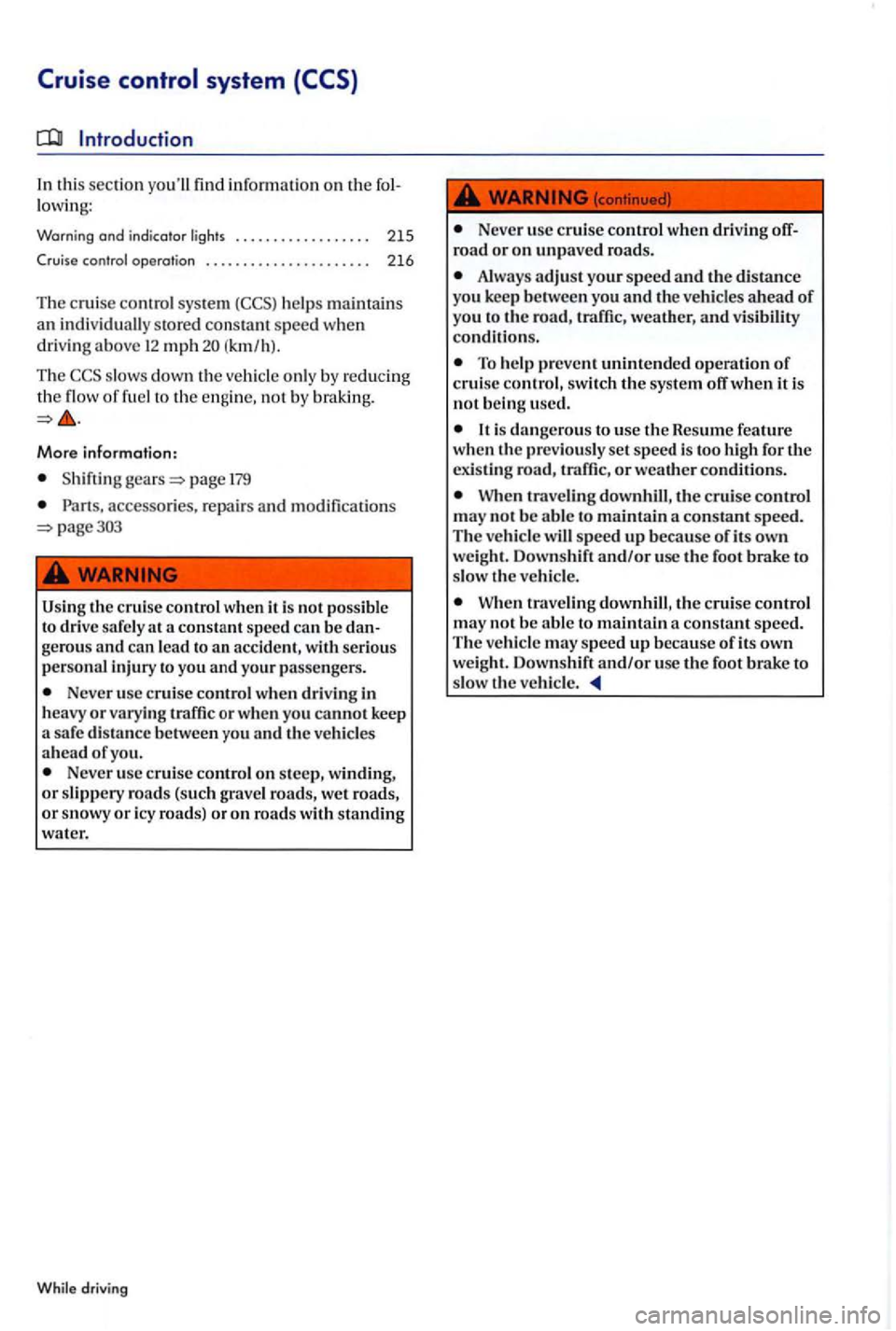
Introduction
th is section yo u'll fin d inform ation on the followi ng:
Warning ond indica tor lights . . . . . . . . . . . . . . . . . . 215
Cruise control operation . . . . . . . . . . . . . .
h elps maint ains
an indiv idually s tored con stan t sp ee d w hen
d ri vin g above 12 mph (km /h).
Th e
More information:
page 179
Parts, acce ssories. repa irs an d modificat io ns page 303
Using the cruise control when it is not possibl e
t o drive safely at a constant speed can b e dan
gerous
Never use cruise control when dri ving in
h eavy or varying traffic or when you cannot keep
a safe distance betwe en you and the ve hicle s ahead of you. Never use cruise contro l on ste ep , winding, or slippery roads (s uch grav el roads, wet roads, or sno\vy or icy road s) or on road s with standing
wat er.
Never use cruise control when driving off
road or on unpave d road s.
Always adjust your speed and the di stance yo u keep betwe en you and the vehicles ahead of you to the weather, and vis ibility condition s.
To he lp prevent unintended operation of crui se control , switch the s y stem off when it is not
It is dange rous to use the Resume feature
wh en th e prev iously set speed is too high for the exis ting traffic, or weather condi tion s.
When traveling downhill , tJ1e cru ise control may no t b e a ble to maintain a cons tant sp eed .
Th e vehicl e will spe ed up b ecause of it s o wn
weight. Downshift and/or usc the foot brake to
s low the ve hicle.
When travelin g downhill , the crui se control may not be able to a constant speed.
The vehicle may speed up b ecause of it s own
weight . Dow nshift and/or u se the foot brak e to
s lo w the vehicle.
Page 214 of 541
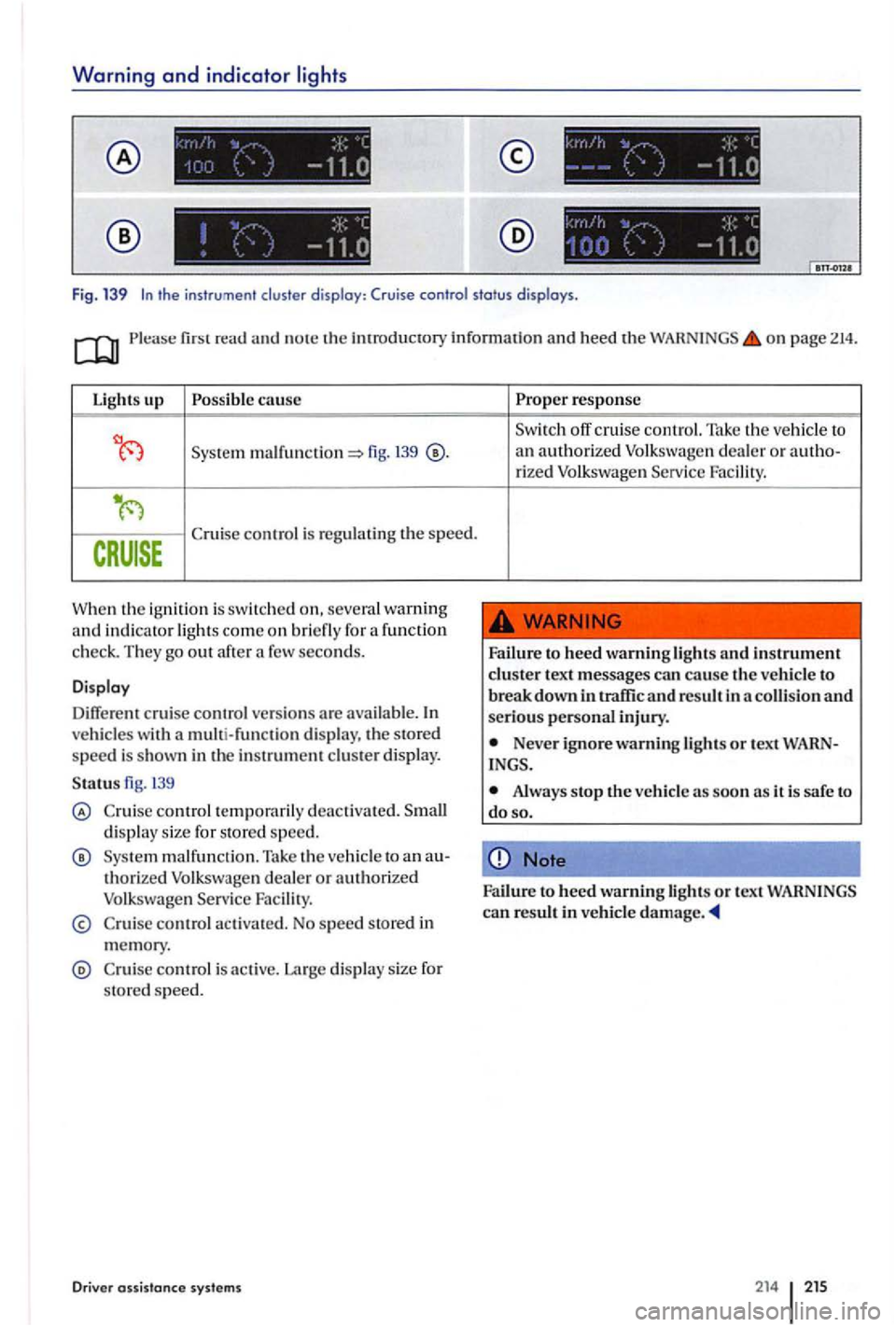
Warning and indicator lights
-
. .
r
Fig. 139 the instrument display : Cruise contro l status displays.
on p age 214.
Light s up Possible cause
139
control is regulating the speed.
When th e ign ition is switched on, seve ral warning
a nd indic ator light s come on briefly for a function
c h eck. They go out after few seconds.
Disp lay
Diffe rent c rui se control versions are available. vehicles wi th a multi-fun ction dis p lay, the sto red
s p eed is s hown in the in strum en t cluste r display.
139
control temporarily deactivated. di sp lay size fo r stored sp ee d.
ma lfunctio n. Take th e ve hicle to a n au
thori zed Volkswagen dealer or authorize d Volkswage n Service Facility.
contro l ac tivated. No speed sto red in
memory .
control i s active. Large display size for
s tored speed.
Drive r assistanc e sys tems
off cruise con trol. Take th e vehicl e to
a n authorized Volkswage n deal er or a u th o-
ri ze d Volkswage n Serv ice Facility.
Failure to hee d warnin g lights and in strument clu ster text message s ca n cause the vehicl e to breakdown in traffic and result in collision and seriou s personal injury.
Neve r ignore warning lights or tex t WARN
Alway s stop it is sa fe to do so.
Note
Failure to heed warning can result in ve hicle